1,2,3-Triazolyl-tetrahydropyrimidine Conjugates as Potential Sterol Carrier Protein-2 Inhibitors: Larvicidal Activity against the Malaria Vector Anopheles arabiensis and In Silico Molecular Docking Study
Abstract
1. Introduction
2. Results and Discussion
2.1. Chemistry
2.2. Larvicidal Activity
2.3. Molecular Docking
2.4. Molecular Dynamics Simulations
3. Materials and Methods
3.1. Chemistry
3.2. Larvicidal Activity
3.3. Data Analysis
3.4. Molecular Modelling
3.5. Molecular Dynamics Simulations
4. Conclusions
Supplementary Materials
Author Contributions
Funding
Institutional Review Board Statement
Informed Consent Statement
Data Availability Statement
Acknowledgments
Conflicts of Interest
Sample Availability
References
- Tokponnon, F.T.; Sissinto, Y.; Ogouyémi, A.H.; Adéothy, A.A.; Adechoubou, A.; Houansou, T.; Oke, M.; Kinde-Gazard, D.; Massougbodji, A.; Akogbeto, M.C.; et al. Implications of insecticide resistance for malaria vector control with long-lasting insecticidal nets: Evidence from health facility data from Benin. Malar. J. 2019, 18, 37. [Google Scholar] [CrossRef] [PubMed]
- Schmidt, M.; Hrabcova, V.; Jun, D.; Kuca, K.; Musilek, K. Vector Control and Insecticidal Resistance in the African Malaria Mosquito Anopheles gambiae. Chem. Res. Toxicol. 2018, 31, 534–547. [Google Scholar] [CrossRef] [PubMed]
- Zlotkin, E. The insect voltage-gated sodium channel as target of insecticides. Annu. Rev. Entomol. 1999, 44, 429–455. [Google Scholar] [CrossRef]
- Carlier, P.R.; Bloomquist, J.R.; Totrov, M.; Li, J. Discovery of Species-selective and Resistance-breaking Anticholinesterase Insecticides for the Malaria Mosquito. Curr. Med. Chem. 2017, 24, 2946–2958. [Google Scholar] [CrossRef]
- Mian, L.S.; Mulla, M.S. Biological and environmental dynamics of insect growth regulators (IGRs) as used against Diptera of public health importance. In Residue Reviews; Springer: New York, NY, USA, 1982; pp. 27–112. [Google Scholar]
- Jindra, M.; Bittova, L. The juvenile hormone receptor as a target of juvenoid “insect growth regulators”. Arch. Insect Biochem. Physiol. 2019, 103, e21615. [Google Scholar] [CrossRef] [PubMed]
- Kim, I.H.; Pham, V.; Jablonka, W.; Goodman, W.G.; Ribeiro, J.M.C.; Andersen, J.F. A mosquito hemolymph odorant-binding protein family member specifically binds juvenile hormone. J. Biol. Chem. 2017, 292, 15329–15339. [Google Scholar] [CrossRef]
- Dyer, D.H.; Lovell, S.; Thoden, J.B.; Holden, H.M.; Rayment, I.; Lan, Q. The structural determination of an insect sterol carrier protein-2 with a ligand-bound C16 fatty acid at 1.35-A resolution. J. Biol. Chem. 2003, 278, 39085–39091. [Google Scholar] [CrossRef]
- Mans, B.J.; Calvo, E.; Ribeiro, J.M.; Andersen, J.F. The crystal structure of D7r4, a salivary biogenic amine-binding protein from the malaria mosquito Anopheles gambiae. J. Biol. Chem. 2007, 282, 36626–36633. [Google Scholar] [CrossRef]
- Taylor, E.A.; Rinaldo-Matthis, A.; Li, L.; Ghanem, M.; Hazleton, K.Z.; Cassera, M.B.; Almo, S.C.; Schramm, V.L. Anopheles gambiae purine nucleoside phosphorylase: Catalysis, structure, and inhibition. Biochemistry 2007, 46, 12405–12415. [Google Scholar] [CrossRef][Green Version]
- Nefisath, P.; Dasappa, J.P.; Haripriya, B.; Chopra, D.; Venugopala, K.N.; Deb, P.K.; Gleiser, R.M.; Mohanlall, V.; Maharaj, R.; Shashiprabha; et al. Synthesis, structural elucidation and larvicidal activity of novel arylhydrazones. J. Mol. Struct. 2021, 1236, 130305. [Google Scholar] [CrossRef]
- Venugopala, K.N.; Ramachandra, P.; Tratrat, C.; Gleiser, R.M.; Bhandary, S.; Chopra, D.; Morsy, M.A.; Aldhubiab, B.E.; Attimarad, M.; Nair, A.B. Larvicidal activities of 2-aryl-2, 3-dihydroquinazolin-4-ones against malaria vector Anopheles arabiensis, In Silico ADMET prediction and molecular target investigation. Molecules 2020, 25, 1316. [Google Scholar] [CrossRef] [PubMed]
- Venugopala, K.N.; Krishnappa, M.; Nayak, S.K.; Subrahmanya, B.K.; Vaderapura, J.P.; Chalannavar, R.K.; Gleiser, R.M.; Odhav, B. Synthesis and antimosquito properties of 2,6-substituted benzo[d]thiazole and 2,4-substituted benzo[d]thiazole analogues against Anopheles arabiensis. Eur. J. Med. Chem. 2013, 65, 295–303. [Google Scholar] [CrossRef] [PubMed]
- Sandeep, C.; Venugopala, K.N.; Gleiser, R.M.; Chetram, A.; Padmashali, B.; Kulkarni, R.S.; Venugopala, R.; Odhav, B. Greener synthesis of indolizine analogues using water as a base and solvent: Study for larvicidal activity against Anopheles arabiensis. Chem. Biol. Drug Des. 2016, 88, 899–904. [Google Scholar] [CrossRef] [PubMed]
- Chandrashekharappa, S.; Venugopala, K.N.; Nayak, S.K.; Gleiser, R.M.; García, D.A.; Kumalo, H.M.; Kulkarni, R.S.; Mahomoodally, F.M.; Venugopala, R.; Mohan, M.K.; et al. One-pot microwave assisted synthesis and structural elucidation of novel ethyl 3-substituted-7-methylindolizine-1-carboxylates with larvicidal activity against Anopheles arabiensis. J. Mol. Struct. 2018, 1156, 377–384. [Google Scholar] [CrossRef]
- Venugopala, K.N.; Gleiser, R.M.; Chalannavar, R.K.; Odhav, B. Antimosquito properties of 2-substituted phenyl/benzylamino-6-(4- chlorophenyl)-5-methoxycarbonyl-4-methyl-3,6-dihydropyrimidin-1-ium chlorides against Anopheles arabiensis. Med. Chem. 2014, 10, 211–219. [Google Scholar]
- Venugopala, K.N.; Gleiser, R.M.; Kasumbwe, K.; Aldhubiab, B.E.; Attimarad, M.V.; Odhav, B. Evaluation of halogenated coumarins for antimosquito properties. Sci. World J. 2014, 2014, 189824. [Google Scholar] [CrossRef]
- Bairagi, K.M.; Venugopala, K.N.; Mondal, P.K.; Gleiser, R.M.; Chopra, D.; García, D.; Odhav, B.; Nayak, S.K. Larvicidal study of tetrahydropyrimidine scaffolds against Anopheles arabiensis and structural insight by single crystal X-ray studies. Chem. Biol. Drug Des. 2018, 92, 1924–1932. [Google Scholar] [CrossRef]
- Nefisath, P.; Prasad Dasappa, J.; Haripriya, B.; Chopra, D.; Venugopala, K.N.; Deb, P.K.; Gleiser, R.M.; Mohanlall, V.; Maharaj, R.; Shashiprabha, S.; et al. Synthesis, characterization and larvicidal activity of novel benzylidene derivatives of fenobam and its thio analogues with crystal insight. J. Mol. Struct. 2021, 1226, 129386. [Google Scholar] [CrossRef]
- Venugopala, K.N.; Nayak, S.K.; Gleiser, R.M.; Sanchez-Borzone, M.E.; Garcia, D.A.; Odhav, B. Synthesis, polymorphism, and insecticidal activity of methyl 4-(4-chlorophenyl)-8-iodo-2-methyl-6-oxo-1, 6-dihydro-4H-pyrimido [2, 1-b] quinazoline-3-carboxylate against Anopheles arabiensis mosquito. Chem. Biol. Drug Des. 2016, 88, 88–96. [Google Scholar] [CrossRef]
- Dharma Rao, B.D.; Bhandary, S.; Chopra, D.; Venugopala, K.N.; Gleiser, R.M.; Kasumbwe, K.; Odhav, B. Synthesis and characterization of a novel series of 1,4-dihydropyridine analogues for larvicidal activity against Anopheles arabiensis. Chem. Biol. Drug Des. 2017, 90, 397–405. [Google Scholar] [CrossRef]
- De Oliveira Pedrosa, M.; Duarte da Cruz, R.M.; de Oliveira Viana, J.; de Moura, R.O.; Ishiki, H.M.; Barbosa Filho, J.M.; Diniz, M.F.; Scotti, M.T.; Scotti, L.; Bezerra Mendonca, F.J. Hybrid Compounds as Direct Multitarget Ligands: A Review. Curr. Top. Med. Chem. 2017, 17, 1044–1079. [Google Scholar] [CrossRef] [PubMed]
- Nepali, K.; Sharma, S.; Kumar, D.; Budhiraja, A.; Dhar, K.L. Anticancer hybrids—A patent survey. Recent Pat. Anticancer Drug Discov. 2014, 9, 303–339. [Google Scholar] [CrossRef] [PubMed]
- Ivasiv, V.; Albertini, C.; Gonçalves, A.E.; Rossi, M.; Bolognesi, M.L. Molecular Hybridization as a Tool for Designing Multitarget Drug Candidates for Complex Diseases. Curr. Top. Med. Chem. 2019, 19, 1694–1711. [Google Scholar] [CrossRef] [PubMed]
- Tratrat, C. Novel Thiazole-Based Thiazolidinones as Potent Anti-infective Agents: In silico PASS and Toxicity Prediction, Synthesis, Biological Evaluation and Molecular Modelling. Comb. Chem. High Throughput Screen. 2020, 23, 126–140. [Google Scholar] [CrossRef]
- Abbot, V.; Sharma, P.; Dhiman, S.; Noolvi, M.N.; Patel, H.M.; Bhardwaj, V. Small hybrid heteroaromatics: Resourceful biological tools in cancer research. RSC Adv. 2017, 7, 28313–28349. [Google Scholar] [CrossRef]
- Meunier, B. Hybrid Molecules with a Dual Mode of Action: Dream or Reality? Acc. Chem. Res. 2008, 41, 69–77. [Google Scholar] [CrossRef]
- Nepali, K.; Sharma, S.; Sharma, M.; Bedi, P.M.; Dhar, K.L. Rational approaches, design strategies, structure activity relationship and mechanistic insights for anticancer hybrids. Eur. J. Med. Chem. 2014, 77, 422–487. [Google Scholar] [CrossRef]
- Gattrell, W.; Johnstone, C.; Patel, S.; Smith, C.S.; Scheel, A.; Schindler, M. Designed multiple ligands in metabolic disease research: From concept to platform. Drug Discov. Today 2013, 18, 692–696. [Google Scholar] [CrossRef]
- Mayer, T.U.; Kapoor, T.M.; Haggarty, S.J.; King, R.W.; Schreiber, S.L.; Mitchison, T.J. Small molecule inhibitor of mitotic spindle bipolarity identified in a phenotype-based screen. Science 1999, 29, 5441. [Google Scholar] [CrossRef]
- Hurst, E.W.; Hull, R. Two New Synthetic Substances Active against Viruses of the Psittacosis-Lymphogranuloma-Trachoma Group. J. Med. Pharm. Chem. 1961, 3, 215–229. [Google Scholar] [CrossRef]
- Karnail, S.A.; Brian, N.S.; Steven, E.U.; David, M.F.; Suzanne, M.; Anders, H.; Brian, C.O.R. Dihydropyrimidine calcium channel blockers. 3. 3-Carbamoyl-4-aryl-1,2,3,4-tetrahydro-6-methyl-5-pyrimidinecarboxylic acid esters as orally effective antihypertensive agents. J. Med. Chem. 1991, 34, 806–811. [Google Scholar]
- Jauk, B.; Pernat, T.; Kappe, C.O. Design and synthesis of a conformationally rigid mimic of the dihydropyrimidine calcium channel modulator SQ 32,926. Molecules 2000, 5, 227–239. [Google Scholar] [CrossRef]
- Venugopala, K.N.; Nayak, S.K.; Pillay, M.; Prasanna, R.; Coovadia, Y.M.; Odhav, B. Synthesis and antitubercular activity of 2-(substituted phenyl/benzyl-amino)-6-(4-chlorophenyl)-5-(methoxycarbonyl)-4-methyl-3,6-dihydropyrimidin-1-ium chlorides. Chem. Biol. Drug Des. 2013, 81, 219–227. [Google Scholar] [CrossRef]
- Wael, A.E.S.; Ibrahim, F.N.; Adel, A.H.; Abdel, R. C-Furyl glycosides, II: Synthesis and antimicrobial evaluation of C-furyl glycosides bearing pyrazolines, isoxazolines, and 5,6-dihydropyrimidine-2(1H)-thiones. Monatsh. Chem. 2009, 140, 365–370. [Google Scholar]
- Sushilkumar, S.B.; Devanand, B.S. Synthesis and anti-inflammatory activity of some 2-amino-6-(4-substituted aryl)-4-(4-substituted phenyl)-1,6-dihydropyrimidine-5-yl-acetic acid derivatives. Acta Pharm. 2003, 53, 223–229. [Google Scholar]
- Rajanarendar, E.; Reddy, M.N.; Murthy, K.R.; Reddy, K.G.; Raju, S.; Srinivas, M.; Praveen, B.; Rao, M.S. Synthesis, antimicrobial, and mosquito larvicidal activity of 1-aryl-4-methyl-3,6-bis-(5-methylisoxazol-3-yl)-2-thioxo-2,3,6,10b-tetrahydro-1H-pyrimido [5,4-c]quinolin-5-ones. Bioorg. Med. Chem. Lett. 2010, 20, 6052–6055. [Google Scholar] [CrossRef] [PubMed]
- Eugene, L.S. Effect of trifluoromethoxy, chlorodifluoromethoxy, and trifluoromethyl on the antimalarial Activity of 5-benzyl- and 5-phenyl-2,4-diaminopyrirnidin. J. Med. Chem. 1973, 16, 1399–1401. [Google Scholar]
- Sanchez-Borzone, M.E.; Mariani, M.E.; Miguel, V.; Gleiser, R.M.; Odhav, B.; Venugopala, K.N.; Garcia, D.A. Membrane effects of dihydropyrimidine analogues with larvicidal activity. Colloids Surf. B 2017, 150, 106–113. [Google Scholar] [CrossRef]
- Chu, X.-M.; Wang, C.; Wang, W.-L.; Liang, L.-L.; Liu, W.; Gong, K.-K.; Sun, K.-L. Triazole derivatives and their antiplasmodial and antimalarial activities. Eur. J. Med. Chem. 2019, 166, 206–223. [Google Scholar] [CrossRef]
- Jayashree, B.S.; Sahu, A.R.; Murthy, M.S.; Venugopala, K.N. Synthesis, determination of partition coefficient and antimicrobial activity of triazolo thiadiazinyl bromocoumarin derivatives. Mat. Sci. Res. Ind. 2005, 3, 187–190. [Google Scholar] [CrossRef]
- Jayashree, B.S.; Sahu, A.R.; Srinivasa, M.M.; Venugopala, K.N. Synthesis, characterization and determination of partition coefficient of some triazole derivatives of coumarins for their anti-microbial activity. Asian J. Chem. 2007, 19, 73–78. [Google Scholar]
- Bhandary, S.; Girish, Y.R.; Venugopala, K.N.; Chopra, D. Crystal structure analysis of [5-(4-methoxyphenyl)-2-methyl-2H-1, 2, 3-triazol-4-yl](thiophen-2-yl) methanone. Acta Cryst. Sec. E 2018, 74, 1178–1181. [Google Scholar] [CrossRef] [PubMed]
- Tratrat, C. 1,2,4-Triazole: A Privileged Scaffold for the Development of Potent Antifungal Agents—A Brief Review. Curr. Top. Med. Chem. 2020, 20, 2235–2258. [Google Scholar] [CrossRef] [PubMed]
- Xu, Z.; Zhao, S.-J.; Liu, Y. 1,2,3-Triazole-containing hybrids as potential anticancer agents: Current developments, action mechanisms and structure-activity relationships. Eur. J. Med. Chem. 2019, 183, 111700. [Google Scholar] [CrossRef]
- Mohamed, M.A.A.; Abd Allah, O.A.; Bekhit, A.A.; Kadry, A.M.; El-Saghier, A.M.M. Synthesis and antidiabetic activity of novel triazole derivatives containing amino acids. J. Het. Chem. 2020, 57, 2365–2378. [Google Scholar] [CrossRef]
- Ahmadi, F.; Ghayahbashi, M.R.; Sharifzadeh, M.; Alipoiur, E.; Ostad, S.N.; Vosooghi, M.; Khademi, H.R.; Amini, M. Synthesis and evaluation of anti-inflammatory and analgesic activities of new 1,2,4-triazole derivatives. Med. Chem. 2014, 11, 69–76. [Google Scholar] [CrossRef] [PubMed]
- Todoulou, O.G.; Papadaki-Valiraki, A.E.; Ikeda, S.; De Clercq, E. Synthesis and antiviral activity of some new 1H-1,2,4-triazole derivatives. Eur. J. Med. Chem. 1994, 29, 611–620. [Google Scholar] [CrossRef]
- Venugopala, K.; Dharma Rao, G.B.; Bhandary, S.; Pillay, M.; Chopra, D.; Aldhubiab, B.E.; Attimarad, M.; Alwassil, O.I.; Harsha, S.; Mlisana, K. Design, synthesis, and characterization of (1-(4-aryl)- 1H-1,2,3-triazol-4-yl)methyl, substituted phenyl-6-methyl-2-oxo-1,2,3,4-tetrahydropyrimidine-5-carboxylates against Mycobacterium tuberculosis. Drug Des. Devel. Ther. 2016, 10, 2681–2690. [Google Scholar] [CrossRef]
- Zhang, S.; Xu, Z.; Gao, C.; Ren, Q.C.; Chang, L.; Lv, Z.S.; Feng, L.S. Triazole derivatives and their anti-tubercular activity. Eur. J. Med. Chem 2017, 138, 501–513. [Google Scholar] [CrossRef]
- Xu, M.; Peng, Y.; Zhu, L.; Wang, S.; Ji, J.; Rakesh, K.P. Triazole derivatives as inhibitors of Alzheimer’s disease: Current developments and structure-activity relationships. Eur. J. Med. Chem. 2019, 180, 656–672. [Google Scholar] [CrossRef]
- Rani, A.; Singh, G.; Singh, A.; Maqbool, U.; Kaur, G.; Singh, J. CuAAC-ensembled 1,2,3-triazole-linked isosteres as pharmacophores in drug discovery: Review. RSC Adv. 2020, 10, 5610–5635. [Google Scholar] [CrossRef]
- Bozorov, K.; Zhao, J.; Aisa, H.A. 1,2,3-Triazole-containing hybrids as leads in medicinal chemistry: A recent overview. Bioorg. Med. Chem. 2019, 27, 3511–3531. [Google Scholar] [CrossRef] [PubMed]
- Zhang, B. Comprehensive review on the anti-bacterial activity of 1,2,3-triazole hybrids. Eur. J. Med. Chem. 2019, 168, 357–372. [Google Scholar] [CrossRef] [PubMed]
- Li, N.; Wang, L.J.; Jiang, B.; Guo, S.J.; Li, X.Q.; Chen, X.C.; Luo, J.; Li, C.; Wang, Y.; Shi, D.Y. Design, synthesis and biological evaluation of novel pyrimidinedione derivatives as DPP-4 inhibitors. Bioorg. Med. Chem. Lett. 2018, 28, 2131–2135. [Google Scholar] [CrossRef]
- Vidadala, R.S.; Ojo, K.K.; Johnson, S.M.; Zhang, Z.; Leonard, S.E.; Mitra, A.; Choi, R.; Reid, M.C.; Keyloun, K.R.; Fox, A.M.; et al. Development of potent and selective Plasmodium falciparum calcium-dependent protein kinase 4 (PfCDPK4) inhibitors that block the transmission of malaria to mosquitoes. Eur. J. Med. Chem. 2014, 74, 562–573. [Google Scholar] [CrossRef][Green Version]
- Service, M.W. Management of vectors. In Pest and Vectors Management in Tropics; Youdeowei, A., Service, M.W., Eds.; Longman: London, UK, 1983; pp. 265–280. [Google Scholar]
- Finney, D.J. Probit Analysis: A Statistical Treatment of the Sigmoid Response Curve, 2nd ed.; Cambridge University Press: New York, NY, USA, 1952. [Google Scholar]
- Chandrashekharappa, S.; Venugopala, K.N.; Tratrat, C.; Mahomoodally, F.M.; Aldhubiab, B.E.; Haroun, M.; Venugopala, R.; Mohan, M.K.; Kulkarni, R.S.; Attimarad, M.V.; et al. Efficient synthesis and characterization of novel indolizines: Exploration of in vitro COX-2 inhibitory activity and molecular modelling studies. New J. Chem. 2018, 42, 4893–4901. [Google Scholar] [CrossRef]
- Case, D.A.; Darden, T.; Cheatham, T.E., III; Simmerling, C.; Wang, J.; Duke, R.E.; Luo, R.; Walker, R.C.; Zhang, W.; Merz, K.M.; et al. AMBER 12; University of California: San Francisco, CA, USA, 2012. [Google Scholar]
- Wang, J.; Wolf, R.M.; Caldwell, J.W.; Kollman, P.A.; Case, D.A. Development and testing of a general amber force field. J. Comput. Chem. 2004, 25, 1157–1174. [Google Scholar] [CrossRef]
- Al-Shar’i, N.A.; Alnabulsi, S.M. Explaining the autoinhibition of the SMYD enzyme family: A theoretical study. J. Mol. Graph. Model. 2016, 68, 147–157. [Google Scholar] [CrossRef]
- Al-Shar’I, N.A.; Musleh, S.S. Identification of CHK1 Kinase Inhibitors Using Structure Based Pharmacophore Modelling and Molecular Docking. Indian J. Pharm. Sci. 2020, 82, 472–482. [Google Scholar] [CrossRef]
- Al-Shar’I, N.; Musleh, S.S. CHK1 kinase inhibition: Identification of allosteric hits using MD simulations, pharmacophore modeling, docking and MM-PBSA calculations. Mol. Divers. 2021. [Google Scholar] [CrossRef]
- Deb, P.K.; Al-Shar’I, N.A.; Venugopala, K.N.; Pillay, M.; Borah, P. In vitro anti-TB properties, in silico target validation, molecular docking and dynamics studies of substituted 1,2,4-oxadiazole analogues against Mycobacterium tuberculosis. J. Enzyme Inhib. Med. Chem. 2021, 36, 869–884. [Google Scholar] [CrossRef] [PubMed]
- Jorgensen, W.L.; Chandrasekhar, J.; Madura, J.D.; Impey, R.W.; Klein, M.L. Comparison of simple potential functions for simulating liquid water. J. Chem. Phys. 1983, 79, 926–935. [Google Scholar] [CrossRef]
- Mark, P.; Nilsson, L. Structure and Dynamics of the TIP3P, SPC, and SPC/E Water Models at 298 K. J. Phys. Chem. A 2001, 105, 9954–9960. [Google Scholar] [CrossRef]
- Ryckaert, J.-P.; Ciccotti, G.; Berendsen, H.J.C. Numerical integration of the cartesian equations of motion of a system with constraints: Molecular dynamics of n-alkanes. J. Comput. Phys. 1977, 23, 327–341. [Google Scholar] [CrossRef]
- Norberg, J.; Nilsson, L. On the Truncation of Long-Range Electrostatic Interactions in DNA. Biophys. J. 2000, 79, 1537–1553. [Google Scholar] [CrossRef]
- Fadrná, E.; Hladečková, K.; Koča, J. Long-range Electrostatic Interactions in Molecular Dynamics: An Endothelin-1 Case Study. J. Biomol. Struct. Dyn. 2005, 23, 151–162. [Google Scholar] [CrossRef]
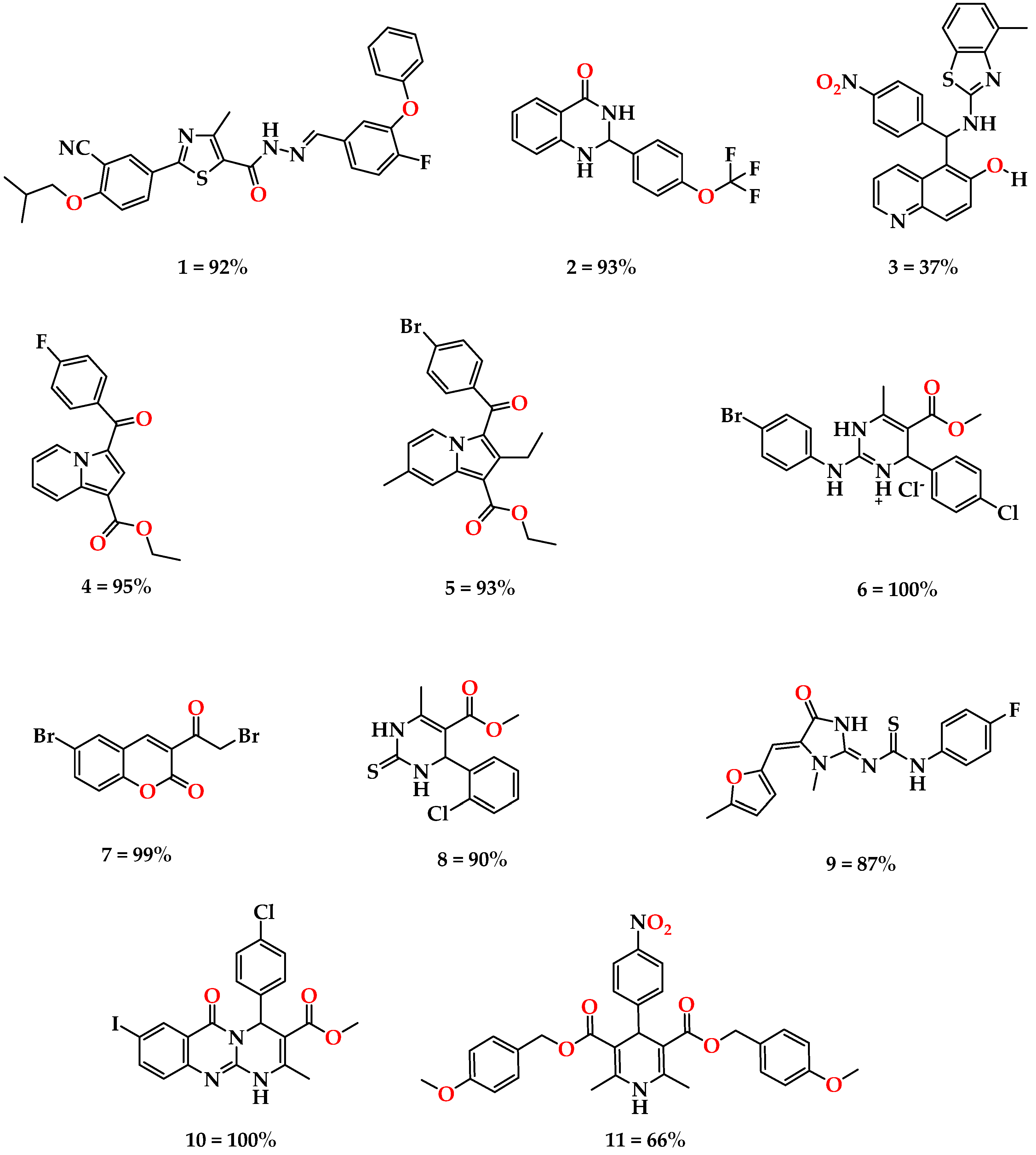

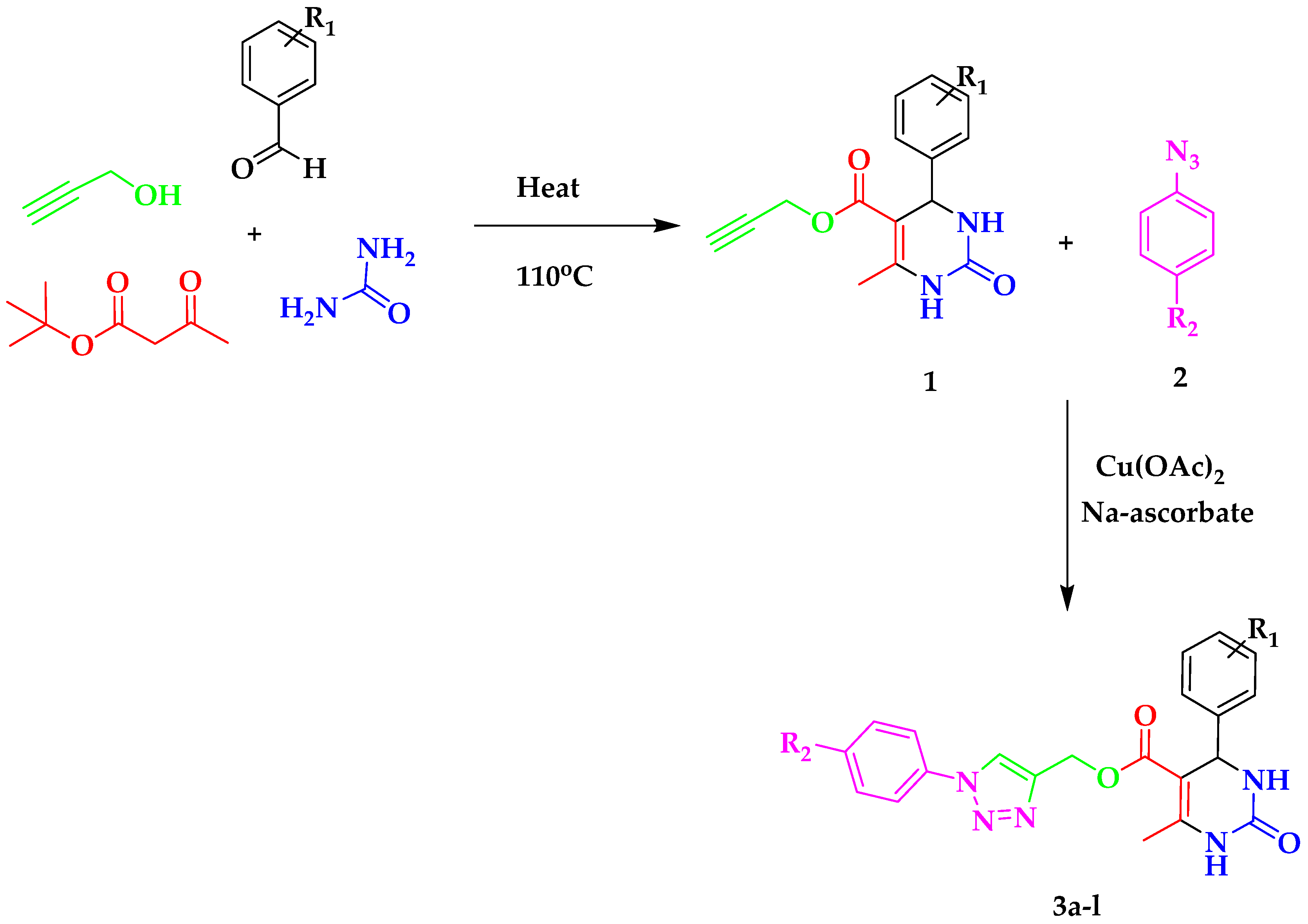
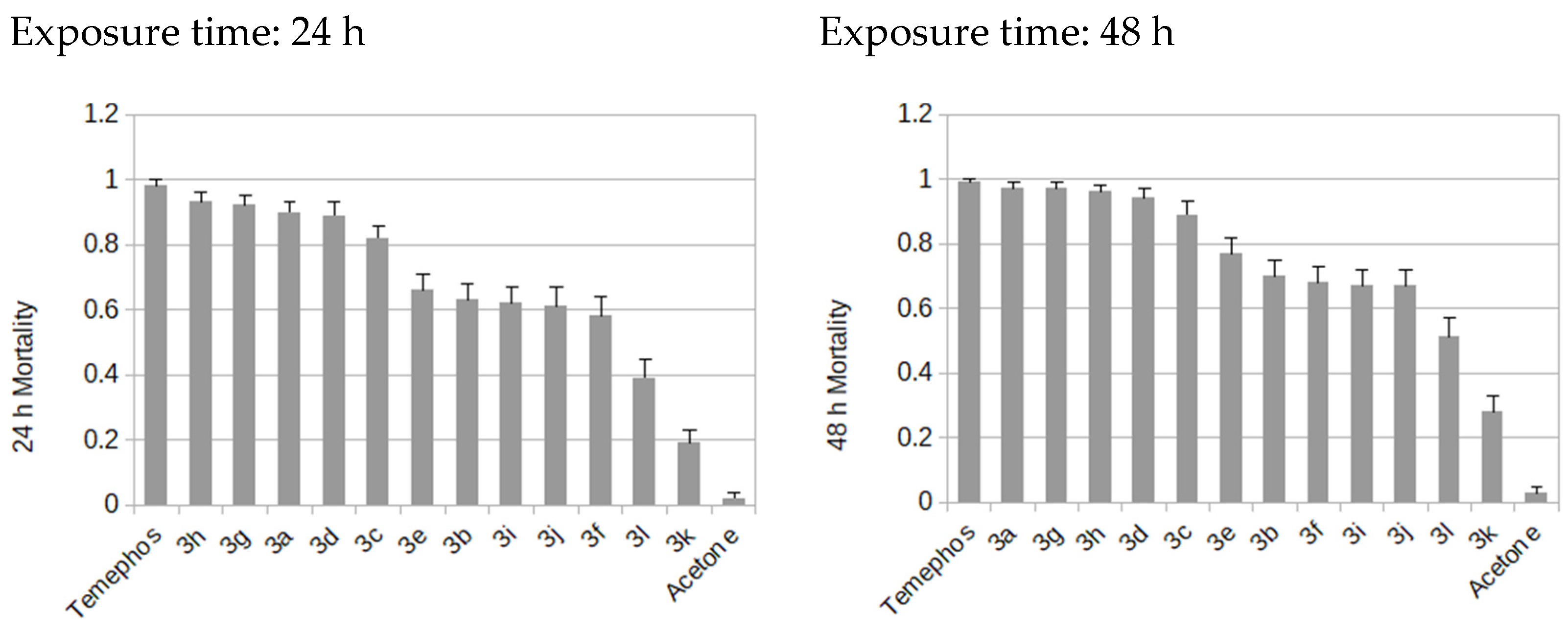
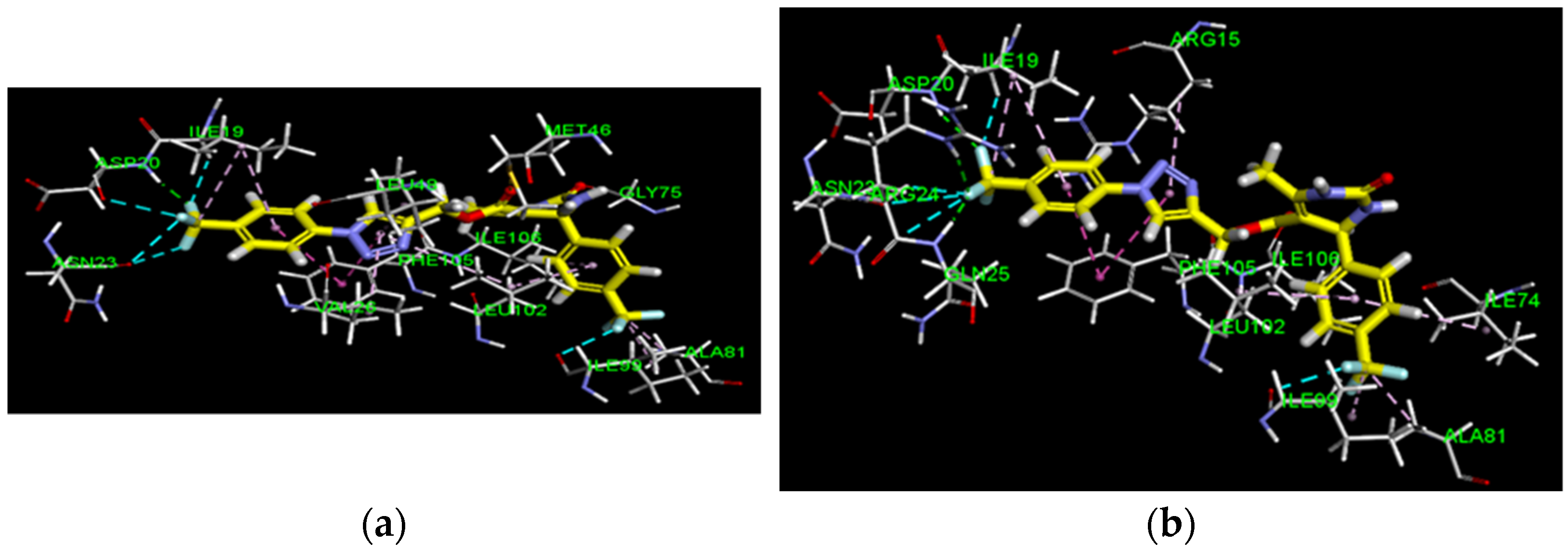
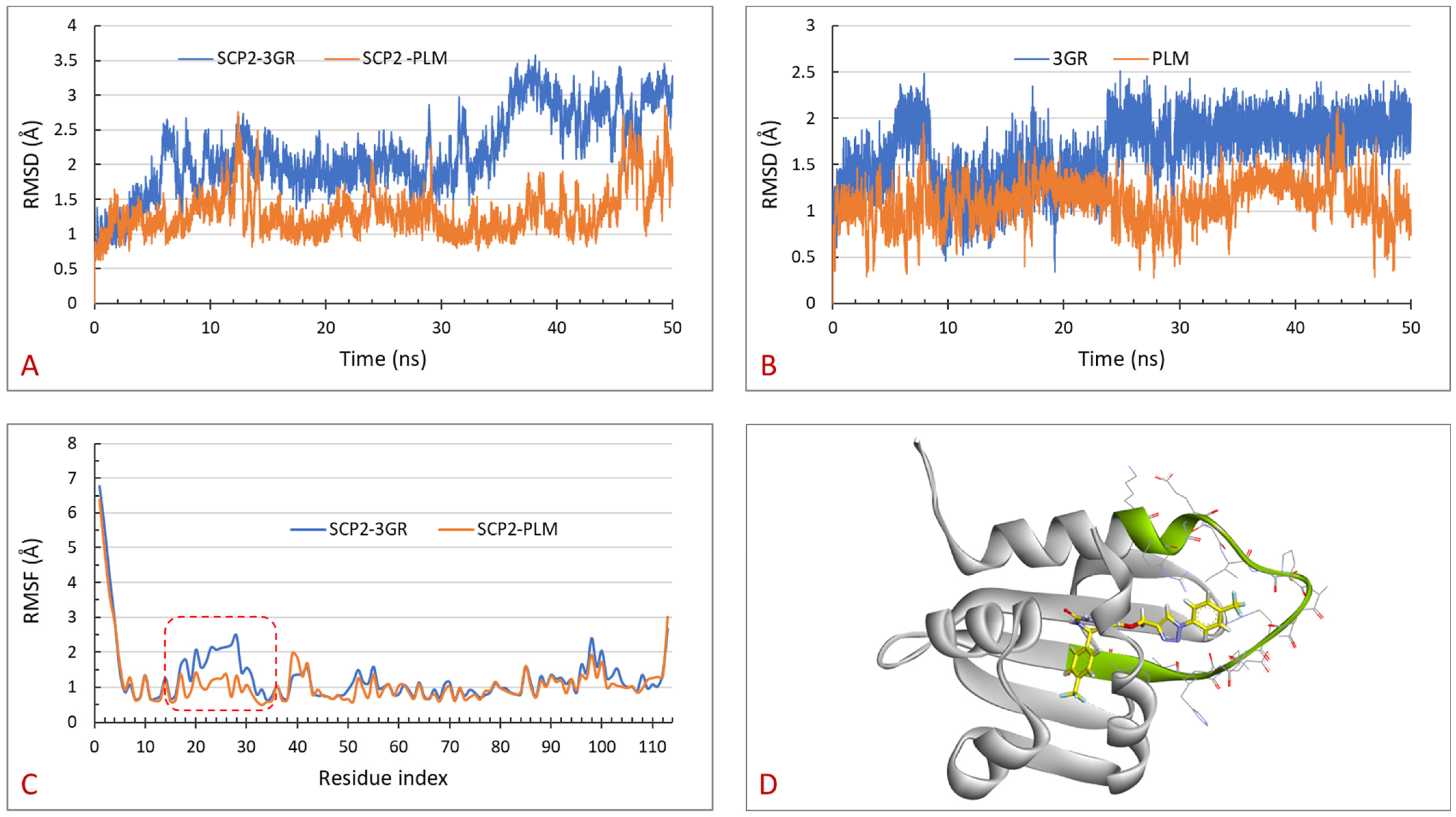
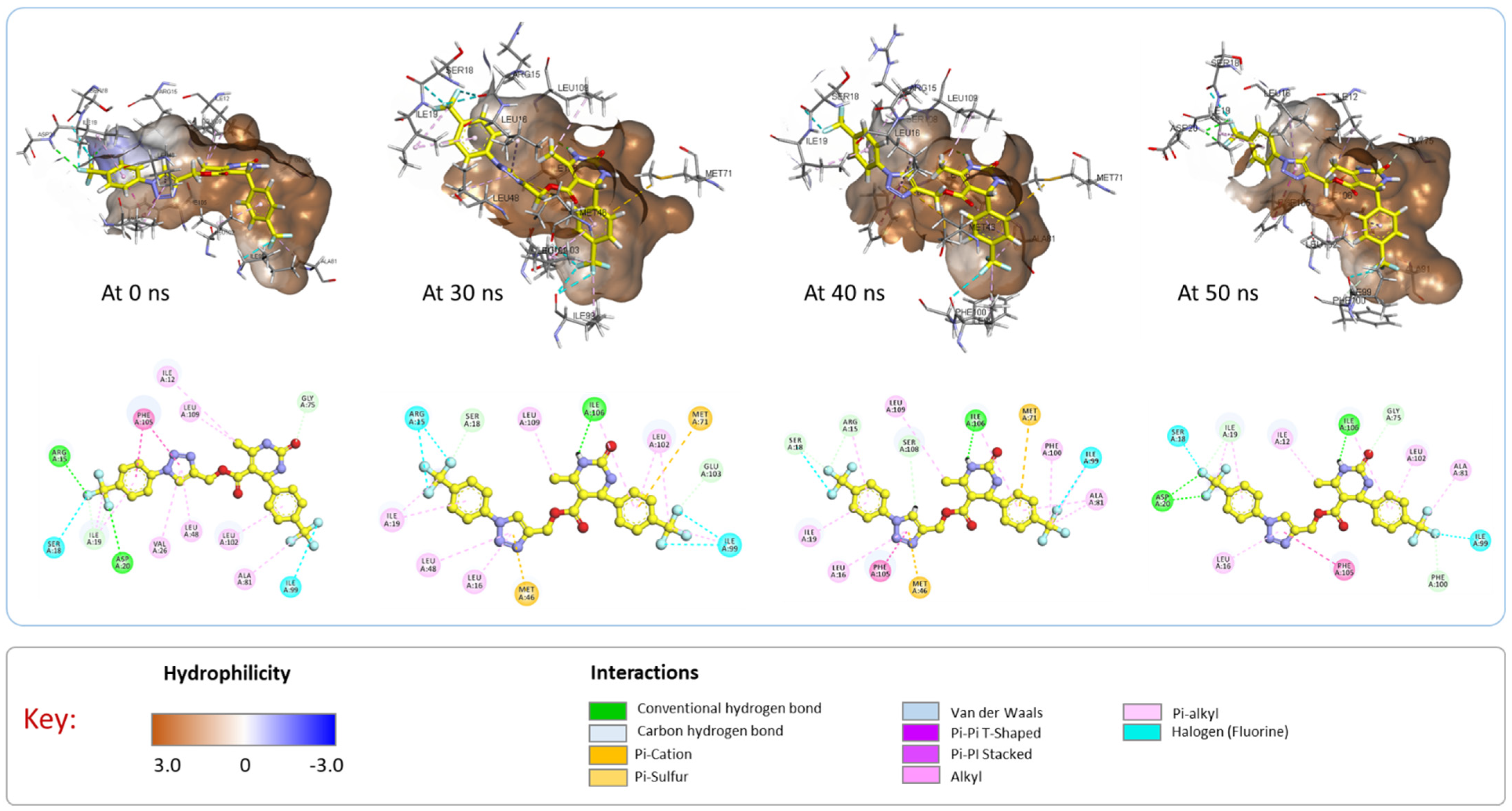
| Compound Code | Mortality of Anopheles Arabiensis Larvae Exposed for 24 h | Mortality of Anopheles Arabiensis Larvae Exposed for 48 h | ||||
|---|---|---|---|---|---|---|
| 1 µg/mL * | 2 µg/mL * | 4 µg/mL * | 1 µg/mL * | 2 µg/mL * | 4 µg/mL * | |
| 3a | 0.19 ± 0.03 abc | 0.59 ± 0.04 de | 0.9 ± 0.03 fg | 0.21 ± 0.04 abcd | 0.64 ± 0.04 ef | 0.97 ± 0.02 g |
| 3b | 0.13 ± 0.03 bchi | 0.33 ± 0.04 jk | 0.63 ± 0.04 e | 0.14 ± 0.03 dhi | 0.36 ± 0.04 jk | 0.70 ± 0.04 el |
| 3c | 0.12 ± 0.03 chi | 0.42 ± 0.04 jl | 0.82 ± 0.03 gm | 0.17 ± 0.03 cdhi | 0.47 ± 0.04 jm | 0.89 ± 0.03 no |
| 3d | 0.2 ± 0.03 abc | 0.58 ± 0.04 de | 0.89 ± 0.03 fg | 0.22 ± 0.04 abcd | 0.62 ± 0.04 efp | 0.94 ± 0.02 gn |
| 3e | 0.07 ± 0.02 ino | 0.24 ± 0.04 ak | 0.66 ± 0.04 e | 0.09 ± 0.03 iqr | 0.29 ± 0.04 ak | 0.77 ± 0.04 ls |
| 3f | 0.07 ± 0.02 ino | 0.21 ± 0.03 abc | 0.58 ± 0.04 de | 0.09 ± 0.03 iqr | 0.24 ± 0.04 abck | 0.68 ± 0.04 el |
| 3g | 0.22 ± 0.04 ab | 0.5 ± 0.04 dl | 0.92 ± 0.02 fq | 0.24 ± 0.04 abck | 0.53 ± 0.04 fmp | 0.97 ± 0.02 g |
| 3h | 0.17 ± 0.03 abch | 0.63 ± 0.04 e | 0.93 ± 0.02 fq | 0.21 ± 0.04 abcd | 0.69 ± 0.04 el | 0.96 ± 0.02 gn |
| 3i | 0.08 ± 0.02 ino | 0.23 ± 0.04 ak | 0.62 ± 0.04 e | 0.10 ± 0.03 hiq | 0.26 ± 0.04 abck | 0.67 ± 0.04 el |
| 3j | 0.09 ± 0.02 hio | 0.26 ± 0.04 ak | 0.61 ± 0.04 de | 0.11 ± 0.03 hiq | 0.28 ± 0.04 abk | 0.67 ± 0.04 el |
| 3k | 0.03 ± 0.03 nop | 0.07 ± 0.02 ino | 0.19 ± 0.03 abc | 0.04 ± 0.02 qrt | 0.10 ± 0.03 hiq | 0.28 ± 0.04 abk |
| 3l | 0.01 ± 0.01 p | 0.13 ± 0.03 bchi | 0.39 ± 0.04 jl | 0.02 ± 0.01 t | 0.18 ± 0.03 bcdh | 0.51 ± 0.04 mp |
| Acetone | 0.02 ± 0.01 np | 0.02 ± 0.01 np | 0.02 ± 0.01 np | 0.02 ± 0.01 t | 0.02 ± 0.01 t | 0.03 ± 0.02 rt |
| Temephos | 0.24 ± 0.04 ak | 0.78 ± 0.04 m | 0.98 ± 0.01 q | 0.27 ± 0.04 abck | 0.82 ± 0.03 os | 0.99 ± 0.01 g |
| Compound Code | 24 h LC50 | 48 h LC50 | Mean LC50 |
|---|---|---|---|
| 3d | 1.86 ± 0.08 a | 1.74 ± 0.08 a | 1.80 ± 0.06 a |
| 3g | 1.81 ± 0.07 a | 1.66 ± 0.10 ab | 1.75 ± 0.06 a |
| 3a | 1.85 ± 0.08 a | 1.65 ± 0.08 ab | 1.74 ± 0.06 a |
| 3h | 1.80 ± 0.08 a | 1.63 ± 0.08 ab | 1.71 ± 0.06 a |
| Temephos | 1.48 ± 0.08 b | 1.43 ± 0.08 b | 1.46 ± 0.06 b |
| Entry | Stereoisomer | Binding Energy (kJ/mol) | Residues Interaction | ||
|---|---|---|---|---|---|
| H-Bond | Fluorine | Pi-Pi | |||
| Native Ligand | - | −96.64 | Arg24, Gln25, Val26 | ||
| 3a | R | −120.16 | Asp20 | Asp20, Asn23 | Phe 105 |
| S | −88.81 | Asp20 | Asp20, Asn23 | Phe 105 | |
| 3b | R | −117.53 | Asp20 | Asp20, Asn23 | Phe 105 |
| S | −119.95 | Asp20, Arg24, Gln25 | Asn23 | Phe 105 | |
| 3c | R | −119.82 | Arg24, Gln25 | Asn23 | Phe 105 |
| S | −64.14 | Arg24, Gln25 | - | Phe 105 | |
| 3d | R | −123.67 | Asp20 | Asp20, Asn23 | Phe 105 |
| S | −119.40 | Asp20, Arg24, Gln25 | Asn23 | Phe 105 | |
| 3e | R | −120.87 | Asp20 | Asp20, Asn23 | Phe 105 |
| S | −121.80 | Asp20, Arg24, Gln25 | Asn23 | Phe 105 | |
| 3f | R | −127.43 | Arg24, Gln25 | Asn23 | Phe 105 |
| S | −105.08 | Arg24, Gln25 | - | Phe 105 | |
| 3g | R | −118.60 | Asp20 | Asp20, Asn23, Ile99 | Phe 105 |
| S | −72.04 | Asp20, Arg24, Gln25 | Asp20, Asn23, Ile99 | Phe 105 | |
| 3h | R | −127.47 | Arg24, Gln25 | Asp20, Arg24, Ile99 | Phe 105 |
| S | −85.41 | Arg24 | Ile99 | Phe 105 | |
| 3i | R | −113.75 | Arg15, Arg24 | - | Phe 105 |
| S | −90.71 | Arg24, Gln25 | - | Phe 105 | |
| 3j | R | −137.51 | Asp20 | Asp20, Asn23 | Phe 105 |
| S | −121.20 | Asp20, Arg24, Gln25 | Asn23 | Phe 105 | |
| 3k | R | −131.34 | Asp20, Arg24 | Asp20, Asn23 | Phe 105 |
| S | −116.49 | Arg15, Asp20 | - | Phe 105 | |
| s | R | −122.15 | Asp20, Arg24 | Asp20, Asn23 | Phe 105 |
| S | −94.19 | Gln25 | - | Phe 105 | |
Publisher’s Note: MDPI stays neutral with regard to jurisdictional claims in published maps and institutional affiliations. |
© 2022 by the authors. Licensee MDPI, Basel, Switzerland. This article is an open access article distributed under the terms and conditions of the Creative Commons Attribution (CC BY) license (https://creativecommons.org/licenses/by/4.0/).
Share and Cite
Venugopala, K.N.; Shinu, P.; Tratrat, C.; Deb, P.K.; Gleiser, R.M.; Chandrashekharappa, S.; Chopra, D.; Attimarad, M.; Nair, A.B.; Sreeharsha, N.; et al. 1,2,3-Triazolyl-tetrahydropyrimidine Conjugates as Potential Sterol Carrier Protein-2 Inhibitors: Larvicidal Activity against the Malaria Vector Anopheles arabiensis and In Silico Molecular Docking Study. Molecules 2022, 27, 2676. https://doi.org/10.3390/molecules27092676
Venugopala KN, Shinu P, Tratrat C, Deb PK, Gleiser RM, Chandrashekharappa S, Chopra D, Attimarad M, Nair AB, Sreeharsha N, et al. 1,2,3-Triazolyl-tetrahydropyrimidine Conjugates as Potential Sterol Carrier Protein-2 Inhibitors: Larvicidal Activity against the Malaria Vector Anopheles arabiensis and In Silico Molecular Docking Study. Molecules. 2022; 27(9):2676. https://doi.org/10.3390/molecules27092676
Chicago/Turabian StyleVenugopala, Katharigatta N., Pottathil Shinu, Christophe Tratrat, Pran Kishore Deb, Raquel M. Gleiser, Sandeep Chandrashekharappa, Deepak Chopra, Mahesh Attimarad, Anroop B. Nair, Nagaraja Sreeharsha, and et al. 2022. "1,2,3-Triazolyl-tetrahydropyrimidine Conjugates as Potential Sterol Carrier Protein-2 Inhibitors: Larvicidal Activity against the Malaria Vector Anopheles arabiensis and In Silico Molecular Docking Study" Molecules 27, no. 9: 2676. https://doi.org/10.3390/molecules27092676
APA StyleVenugopala, K. N., Shinu, P., Tratrat, C., Deb, P. K., Gleiser, R. M., Chandrashekharappa, S., Chopra, D., Attimarad, M., Nair, A. B., Sreeharsha, N., Mahomoodally, F. M., Haroun, M., Kandeel, M., Asdaq, S. M. B., Mohanlall, V., Al-Shar’i, N. A., & Morsy, M. A. (2022). 1,2,3-Triazolyl-tetrahydropyrimidine Conjugates as Potential Sterol Carrier Protein-2 Inhibitors: Larvicidal Activity against the Malaria Vector Anopheles arabiensis and In Silico Molecular Docking Study. Molecules, 27(9), 2676. https://doi.org/10.3390/molecules27092676













